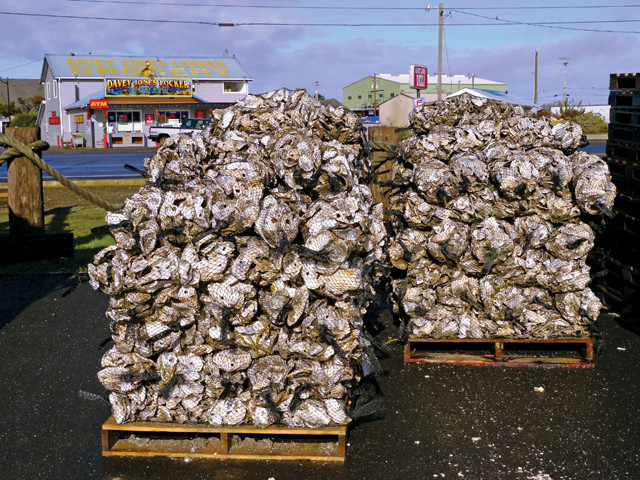
by Chris Micucci Tuesday, October 16, 2018

Shellfish such as oysters are a big business in the Pacific Northwest, but some places have seen mass mortalities of larvae in recent years due to acidic oceans. Credit: Rick Obst, CC BY 2.0.
Global ocean chemistry is changing at a historically unprecedented rate, with rising ocean acidity threatening populations of shellfish and other marine species worldwide. Recent observed changes in ocean chemistry off U.S. coasts, particularly along the shores of Alaska, California, Oregon and Washington, where fisheries are already being affected, have scientists studying the potential impacts, fishermen worrying about their livelihoods, and politicians pushing for action.
Ocean acidification occurs when carbon dioxide dissolves in ocean water, producing carbonic acid and lowering the pH of the water. Approximately 25 to 30 percent of the carbon dioxide absorbed by oceans comes from the atmosphere; the rest comes from other sources, including runoff, hydrothermal vents, submarine volcanism and the decay of organic material. Since the beginning of the industrial revolution, the rise in carbon dioxide levels in the atmosphere — from 280 parts per million (ppm) to more than 400 ppm currently — has led to an increase in carbon dioxide absorbed by the ocean, and a 30 percent increase in ocean acidity: The average pH over the global oceans during that period has dropped from 8.16 to 8.07. And it is projected to drop to 7.67 by 2100 if carbon dioxide emissions continue at the same pace.
Decreased pH causes carbonate, an essential building block in the shells and skeletons of calcifying marine species like oysters, clams and corals, to become relatively less abundant in ocean water, thus posing a serious threat to the health and survival of such animals.
The Pacific Northwest is particularly susceptible to negative impacts of ocean acidification because seasonal upwelling events occur along the coast, forming the basis of many fisheries. Upwelling events occur naturally, involving cool, carbon dioxide-rich water ascending to the ocean surface, driving down the pH. This compounded input of carbon dioxide through upwelling events and increased absorption from the atmosphere has already impacted shellfish farms on the coasts of Oregon and Washington, where in the past decade, there have been some near-total failures of hatcheries. Since 2007, the Whiskey Creek Shellfish Hatchery in Netarts Bay, Ore., for example, has undergone mass mortalities of oyster larvae each year. In an area where shellfish is a $111 million industry and supplies thousands of jobs, business owners are growing more concerned. In response, federal and state politicians have sought to address this issue by pushing for legislation to better understand the problem.
In 2009, the Federal Ocean Acidification Research and Monitoring (FOARAM) Act was signed into law, establishing the NOAA Ocean Acidification Program, which established an intricate network of monitoring buoys and wave gliders that report ocean chemistry data in real time, allowing scientists to study short- and long-term trends. The program also provides financial support for research studying the impacts of ocean acidification on economically and ecologically important species, like shellfish and plankton; and there’s a strong education and outreach component to communicate with the public about scientific findings and the potential impacts of ocean acidification on society.
The FOARAM Act was written to be a living document, changing as our scientific capabilities change. Recently, members of Congress introduced legislation to update the act to accommodate new scientific innovations. Building off of previous legislation championed by former U.S. Rep. Sam Farr, D-Calif., on June 28, 2018, Rep. Suzanne Bonamici, D-Ore., introduced the Coastal and Ocean Acidification Stressors and Threats Research Act, or COAST Research Act, which was co-sponsored by Reps. Don Young, R-Alaska, and Bill Posey, R-Fla. The COAST Research Act would amend the FOARAM Act to add an ocean acidification advisory board, composed of members from the seafood industry, academia, and regional ocean and coastal acidification networks. These participants would provide advice regarding federal activities related to ocean acidification and recommend the best paths for research and monitoring in the future. In addition, the COAST Research Act would establish an ocean acidification data archive and provide grants for education and outreach activities. The bill now awaits consideration by the House Committee on Science, Space and Technology.
In January 2018, the Senate passed a bill introduced by Sen. Roger Wicker, R-Miss., called the Coordinated Ocean Monitoring and Research Act, that also addresses an array of NOAA ocean monitoring and research initiatives. Among other things, the Senate bill would require an interagency committee, originally created by the FOARAM Act for oversight and development of federal ocean acidification research, to produce an economic vulnerability assessment to identify gaps in ocean acidification research and monitoring and improve our understanding of how acidification is impacting economically important species. That bill also currently awaits action from the House.
While these bills would update federal research initiatives, state and local governments have been developing their own programs as well.
In February 2012, for example, then-Washington Gov. Christine Gregoire created the Washington State Blue Ribbon Panel on Ocean Acidification to maintain public and private partnerships to expand Washington’s monitoring network and research the local impacts of acidification. It also seeks to remediate the impacts of acidification through the development of new water treatment methods and aquaculture designs. Similar efforts are being pursued in Alaska by the Alaska Ocean Acidification Network established in 2016.
© 2008-2021. All rights reserved. Any copying, redistribution or retransmission of any of the contents of this service without the expressed written permission of the American Geosciences Institute is expressly prohibited. Click here for all copyright requests.